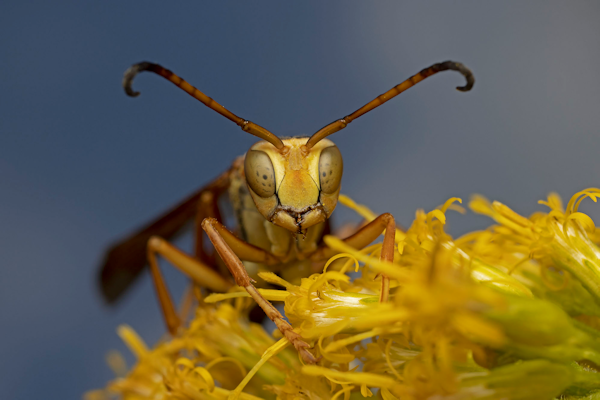SEJournal Online is the digital news magazine of the Society of Environmental Journalists. Learn more about SEJournal Online, including submission, subscription and advertising information.
 |
 |
| Painted in pastel hues, the rosy maple moth showcases the unexpected beauty and cuteness of insects. Photo: Courtesy Danae Wolfe. |
Feature: From Fear to Fascination — A New Insect Narrative
By Danae Wolfe
As a child, I was terrified of insects and spiders. I saw them as tiny monsters — creepy, scary and entirely unwelcome. Spiders lurking in the corners of my bedroom sparked panic. The buzz of bees and wasps sent me running.
The media only reinforced my fears, portraying insects as menacing, deadly pests, as dangerous swarms or grotesque creatures straight from the depths of nightmares.
But picking up a camera changed everything. Suddenly, I was no longer looking at a blur of wings and too many legs. From behind the lens, I could see intricate patterns, endearing behaviors and, dare I admit, cute faces.
It was as if I’d discovered
an entirely new world,
one I had previously —
and purposefully — avoided.
It was as if I’d discovered an entirely new world, one I had previously — and purposefully — avoided. Only now, I found myself drawn to learning more about these animals and the world in which they dwelled.
That shift in perception — from fear to fascination — set me on a path of insatiable curiosity and appreciation for insects and spiders (or what most people colloquially call “bugs”).
And it’s a path that more people, including journalists, should take.
Why insects matter
From pollination and decomposition to predation and serving as the foundation of countless food webs, the contributions of insects and spiders to the world are unmatched.
 |
| With wide, inquisitive eyes and an almost playful demeanor, the peppered jumping spider defies expectations and reveals the surprising charm of arachnids. Photo: Courtesy Danae Wolfe. |
Simply put, entire ecosystems would collapse without bugs.
Yet insect populations are plummeting. Habitat loss, agricultural intensification, urbanization, climate change, pesticide use and light pollution all play interconnected and complex roles in their decline.
And this isn’t just an ecological crisis; it’s a journalism crisis. Because if the stories of insects aren’t being told — if their importance, their beauty and their plight aren’t making it into the public conversation — how can we expect people to care enough to act?
Why write about insects
Insects offer some of the most compelling, accessible and overlooked stories in environmental reporting.
 |
| In a tender display of maternal care, this oak treehopper mother watches over her children throughout their entire juvenile development, challenging the idea that insects are unfeeling or unrelatable creatures. Photo: Courtesy Danae Wolfe. |
With more than 1 million described species and millions more yet to be discovered, they are everywhere around us.
Whether you live in a bustling city or a rolling rural landscape, you likely encounter insects on a daily basis. This accessibility makes them a powerful entry point for people who might not otherwise engage with environmental issues.
Insects can serve as
powerful metaphors for
larger environmental issues.
But beyond their ecological significance, insects can serve as powerful metaphors for larger environmental issues.
Stories about declining monarch butterfly populations can open discussions about habitat fragmentation and climate change. Articles on fireflies disappearing from backyards can illuminate the broader consequences of light pollution. Even a deep dive into the resilience of cockroaches can spark conversations about urban ecology and adaptation in a changing world.
More than ever, journalism needs hopeful narratives. Conservation, at its core, is an act of hope.
When we write about insects, we’re not just reporting on science. We’re inviting people to slow down, to observe and to rediscover a sense of wonder. We’re offering them a way of seeing the world that is joyful, empowering and deeply connected to the ecosystems that sustain us.
Breaking the fear-driven narrative
Historically, media coverage of insects has leaned into sensationalism. Headlines scream about “deadly swarms” or “unstoppable invasions,” reinforcing fear and disgust.
 |
| The monarch butterfly has become an icon of insect conservation, proving that positive media attention can transform public perception and inspire action — something all insects deserve. Photo: Courtesy Danae Wolfe. |
But what if, instead, journalists framed these creatures through the lens of curiosity and admiration? What if we highlighted the architects behind delicate silk webs, the engineers of underground ant highways or the pollinators responsible for one out of every three bites of food we eat?
Reframing the narrative doesn’t mean ignoring human-insect conflicts.
Mosquitoes spread disease. Invasive species disrupt ecosystems. Agricultural pests threaten food security. But there is a way to tell these stories with nuance, ensuring that even the most "problematic" insects are covered in ways that acknowledge their ecological roles.
Good reporting doesn’t just stop at fear; it digs deeper, offering solutions, alternative perspectives and insights that challenge knee-jerk reactions.
Practical tips for reporting on insects
Here are a few tips for journalists looking to incorporate insects into their reporting:
 |
| Nearly invisible among petals and leaves, the jagged ambush bug reminds us that slowing down and sharpening our focus allows us to uncover hidden wonders in the natural world. Photo: Courtesy Danae Wolfe. |
- Look local: You don’t need to travel to the Amazon to find a great insect story. Your own backyard, city park or community garden is teeming with overlooked narratives of the creatures that live among us.
- Talk to entomologists: Scientists studying insects are often eager to share their knowledge. Universities, local conservation groups and extension offices are great places to kick-start the conversation and uncover locally relevant stories.
- Challenge the horror tropes: Resist the urge to lean into sensationalism. Instead of “Murder Hornets Invade!” consider “Understanding the Role of Hornets in Ecosystems.” You might be surprised to learn that wasps are especially important predators in the garden, and they aren’t too shabby at pollination.
- Connect to bigger issues: Use insects as entry points into broader environmental conversations about climate change and biodiversity loss. For example, sustaining healthy insect populations is critical for safeguarding a myriad of other beloved wildlife, including birds. Helping people understand and appreciate this interconnectedness can drive deeper support for their protection.
- Emphasize solutions: No article on insects would be complete without highlighting the many ways we can help protect these diverse creatures. From planting native gardens and removing invasive species to leaving your fall leaves on the ground and even participating in community science initiatives, there are so many ways readers can take action. Be sure to include pragmatic ways for people to get involved locally.
A call to see differently
As journalists, you have the power to shift the dominant narrative about bugs away from fear and disgust toward curiosity and admiration.
 |
| Northern paper wasps are often misunderstood, but they play a crucial role in ecosystems as pest controllers and pollinators. Photo: Courtesy Danae Wolfe. |
By choosing to write about insects and spiders, you aren’t just filling a gap in coverage; you’re fostering a new generation of everyday conservationists. Because the more people learn to see insects not just as pests, but as essential and even charming creatures with complex lives, the more they will feel called to protect them.
To see insects in this way
requires a deliberate slowing down,
a willingness to pay attention
to the unnoticed.
To see insects in this way requires a deliberate slowing down, a willingness to pay attention to the unnoticed.
 |
| Once abundant summer spectacles, fireflies are vanishing due to habitat loss and light pollution. But positive media attention can shine a light on their decline, sparking action to protect their enchanting glow for generations to come. Photo: Courtesy Danae Wolfe. |
It means watching the careful choreography of an orb-weaver spinning its web in the moonlight, or the patient posturing of a camouflaged ambush bug awaiting its next meal.
It means appreciating the tiny dramas unfolding unnoticed all around us — the dance of a male peacock jumping spider as it attempts to woo a mate, the defensive attacks of an oak treehopper mother as she protects her brood of nymphs or the unique flash patterns of fireflies as they bejewel summer nights.
This shift in perception isn’t just about insects; it’s about the world as a whole.
When we teach ourselves and our audiences to see differently, we open the door to a deeper relationship with nature, a relationship built on awe, respect and an understanding that every small life matters.
It is in these fleeting, everyday observations that conservation takes root, no longer as an abstract idea, but as an intimate, personal experience grounded in curiosity, in discovery and in hope for a better tomorrow.
 |
| The author. Photo: Denice Hazlett |
Danae Wolfe is an award-winning conservation photographer, writer and TEDx speaker passionate about helping people see backyard bugs in a new light.
A firm believer in the power of small actions, she inspires gardeners to appreciate the beauty of our natural world and embrace their role in its protection.
Her work has been featured by CNN, The American Gardener and Nature Conservancy Magazine, and she was named Garden Communicators International’s 2022 Emergent Communicator.
Through her homegrown conservation initiative, Chasing Bugs, Danae connects global audiences with the wonder of insects, and her new book, “Grass Isn’t Greener,” shows how simple changes in our yards can create lasting impact for the planet.
* From the weekly news magazine SEJournal Online, Vol. 10, No. 22. Content from each new issue of SEJournal Online is available to the public via the SEJournal Online main page. Subscribe to the e-newsletter here. And see past issues of the SEJournal archived here.











 Advertisement
Advertisement 



